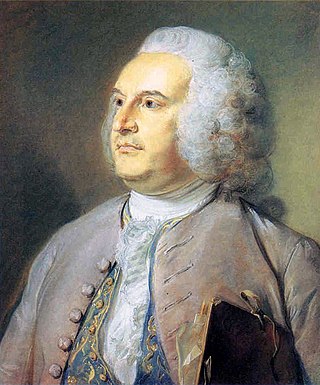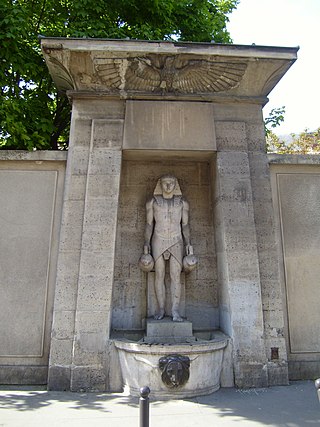Folie-Boutin or Grand Tivoli (1795-1810)
In 1766, Simon Gabriel Boutin (1720-1794), a son of the wealthy farmer-general Boutin, had several houses built in a park of eight hectares, resplendent with rare plants, English, Italian, and Dutch gardens, a bowling green, and follies including false ruins, rocky promontories, and a waterfall. He named the ensemble Tivoli in honor of the gardens of the Villa d'Este in Rome, and the Folie Boutin, as it was often called, quickly became known for its splendid gardens. Its main entrance was located rue de Clichy, with a secondary entrance on rue Saint-Lazare. Two principal buildings were at n°102, la rue Saint-Lazare, and at n°27, la rue de Clichy. A pavilion, attributed to architect François Dominique Barreau de Chefdeville (1725-1765), housed a mineralogical collection. There on Thursdays Boutin received his friends, including painter Hubert Robert and architect Alexandre-Théodore Brongniart.
Boutin was guillotined on July 17, 1794, during the Reign of Terror, and the park put under sequestration. In 1795, the Folie Boutin opened to the public, formally taking the name of Tivoli and becoming the ancestor of amusement parks. During its time as a public garden, it was a favorite entertainment spot for Parisian high society, with amusements including panoramas, marionnettes, and magic lantern shows. From 1796 to 1797 a counter-revolutionary society, called Clichy, occupied the site, but Boutin's heirs recovered Tivoli by a lawsuit in 1797. In 1799, a bath opened on the site (Les eaux thermales et minérales de Tivoli). Following the damage caused by the bivouacking of Napoleon's troops before their departure for Spain, the garden was closed on August 30, 1810.

The Jardin du Luxembourg, known in English as the Luxembourg Garden, colloquially referred to as the Jardin du Sénat, is located in the 6th arrondissement of Paris, France. The creation of the garden began in 1612 when Marie de' Medici, the widow of King Henry IV, constructed the Luxembourg Palace as her new residence. The garden today is owned by the French Senate, which meets in the Palace. It covers 23 hectares and is known for its lawns, tree-lined promenades, tennis courts, flowerbeds, model sailboats on its octagonal Grand Bassin, as well as picturesque Medici Fountain, built in 1620. The name Luxembourg comes from the Latin Mons Lucotitius, the name of the hill where the garden is located.

The Compagnie des chemins de fer de Paris à Lyon et à la Méditerranée, also known as the Chemins de fer Paris-Lyon-Méditerranée or simply PLM, established in 1857, was one of France’s main railway companies until the nationalization of all French railways and establishment of the Société nationale des chemins de fer français (SNCF) on 1 January 1938.

Louis Tullius Joachim Visconti was an Italian-born French architect and designer.

The rue Saint-Honoré is a street in the 1st arrondissement of Paris, France.

Jean-Michel Chevotet was a French architect. He and Pierre Contant d'Ivry were among the most eminent Parisian architects of the day and designed in both the restrained French Rococo manner, known as the "Louis XV style" and in the "Goût grec" phase of early Neoclassicism. His grandson was Pierre-Jean-Baptiste Chaussard.

Saint-Lazare Prison was a prison in the 10th arrondissement of Paris, France. It existed from 1793 until 1935 and was housed in a former motherhouse of the Vincentians.

The Casino de Paris, located at 16, rue de Clichy, in the 9th arrondissement, is one of the well known music halls of Paris, with a history dating back to the 18th century. Contrary to what the name might suggest, it is a performance venue, not a gambling house. The closest métro/RER stations are Liège, Trinité – d'Estienne d'Orves, and Haussmann – Saint-Lazare.

The Medici Fountain is a monumental fountain in the Jardin du Luxembourg in the 6th arrondissement in Paris. Built in about 1630, it was commissioned by Marie de' Medici, the widow of King Henry IV of France and regent of King Louis XIII of France. It was moved to its present location and extensively rebuilt in 1864-1866.

The Fontaine Louvois is a monumental public fountain in Square Louvois on the rue Richelieu in the Second Arrondissement of Paris, near the entrance of the Bibliothèque nationale de France. It was built between 1836 and 1839 during the reign of King Louis-Philippe.

Jean Beausire was an architect, engineer and fountain-maker and the chief of public works in Paris for King Louis XIV of France and King Louis XV of France between 1684 and 1740, and was the architect of all the public fountains constructed in Paris that period. Several of his fountains still exist and continue to work. Three streets in the 4th arrondissement of Paris today carry his name: Rue Jean-Beausire, Impasse Jean-Beausire, and Passage Jean-Beausire.

IN Group is a French company specialized in the production of secure documents such as identity cards and passports, which it designs and sells to various governments and companies.

The Rue Burdeau is a street located in the 1st arrondissement of Lyon, at the bottom of the slopes of La Croix-Rousse, just above the Église Saint-Polycarpe, between the Saône and the Rhône. It leads at one side to the Montée Saint-Sébastien and at the other to the Jardin des Plantes and crosses the montée de la Grande Côte which renovation is completed. The street belongs to the zone classified as World Heritage Site by UNESCO.

The Fontaine du Fellah, also known as the Egyptian Fountain, located at 52 rue de Sèvres in the 7th arrondissement of Paris, next to the entrance of the Vaneau metro station, was built in 1806 during the rule of Napoleon Bonaparte, in the neo-Egyptian style inspired by Napoleon's Egyptian campaign. It is the work of architect François-Jean Bralle and sculptor Pierre-Nicolas Beauvallet. It has been listed since 1977 as a monument historique by the French Ministry of Culture.
François-Jean Bralle was a French architect and engineer, best known as for the construction of fountains in Paris during the time of Napoleon Bonaparte. Bralle was commissioned to build fifteen new fountains in Paris, including the fontaine de Mars, the fontaine du Fellah, and the Fontaine du Palmier in the Place du Châtelet, which are still functioning today.

The Fontaine de Léda, also sometimes referred to as the Fontaine du Regard, is a Parisian sculptural wall fountain built in 1806–1808 during the reign of Napoleon Bonaparte. The fountain depicts the legend of Leda and the Swan, with a central bas-relief panel by Achille Valois. It was originally located at the corner of the rue de Vaugirard and rue du Regard, hence the alternative name; however, in 1864, during the reconstruction of Paris by Emperor Louis Napoleon, the fountain was moved to the back side of the Medici Fountain in the Luxembourg Garden, where it remains.

Léon Azéma was a French architect. He is responsible for many public works in France, especially in and around Paris. His most famous work is 1937 Palais de Chaillot, facing the Eiffel Tower in Paris.

Paris today has more than 421 municipal parks and gardens, covering more than three thousand hectares and containing more than 250,000 trees. Two of Paris's oldest and most famous gardens are the Tuileries Garden, created in 1564 for the Tuileries Palace, and redone by André Le Nôtre in 1664; and the Luxembourg Garden, belonging to a château built for Marie de' Medici in 1612, which today houses the French Senate. The Jardin des Plantes was the first botanical garden in Paris, created in 1626 by Louis XIII's doctor Guy de La Brosse for the cultivation of medicinal plants. Between 1853 and 1870, the Emperor Napoleon III and the city's first director of parks and gardens, Jean-Charles Adolphe Alphand, created the Bois de Boulogne, the Bois de Vincennes, Parc Montsouris and the Parc des Buttes Chaumont, located at the four points of the compass around the city, as well as many smaller parks, squares and gardens in the neighborhoods of the city. One hundred sixty-six new parks have been created since 1977, most notably the Parc de la Villette (1987–1991) and Parc André Citroën (1992).

The Rue du Faubourg-Poissonnière marks the boundary between the 9th and 10th arrondissements of Paris, the main thoroughfare of the old Faubourg Poissonnière district.


















